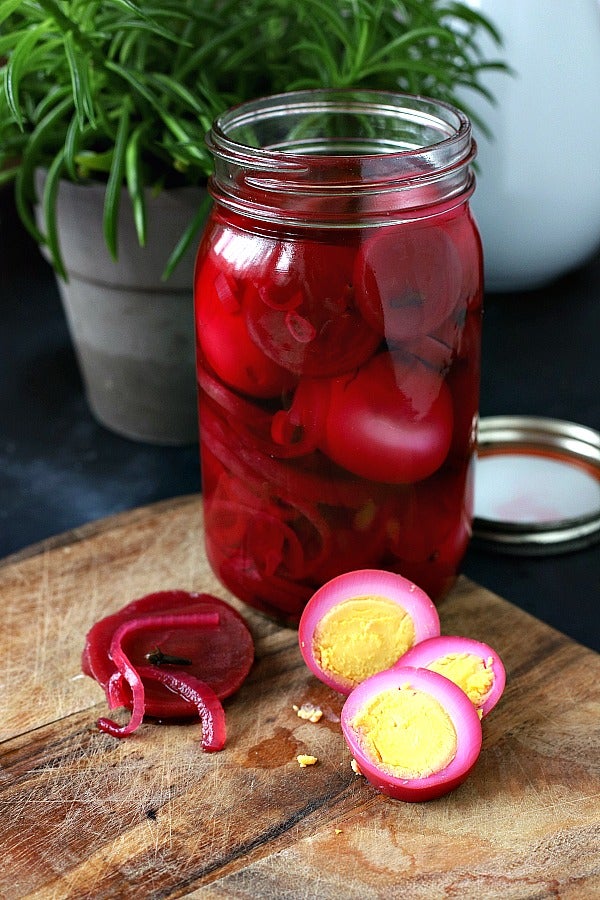How to make the perfect refrigerated pickled egg
Published 12:02 pm Wednesday, March 31, 2021

- (Photo submitted by Louise Hinsley)
|
Getting your Trinity Audio player ready...
|
As we approach the Easter holiday, boiling eggs seems a part of my family rituals. Oh, and dyeing the eggs…starting with the lightest to darkest colors, carefully dipping a little deeper in the next color and the next will create the masterpiece, “The Striped Easter Egg.” If all of this sounds familiar and you have more boiled eggs cooked than you can possibly eat in a week you might want to try making Refrigerated Pickled Eggs. You may recall a large jar of pickled eggs beside the large jar of dill pickles in a country store that were made commercially and were self-stable. According to the National Center for Home Food Preservation, there are no home canning directions for pickled eggs. All of the following pickled egg recipes are for storage in the refrigerator for three to four months. Pickled eggs should never be at room temperature except for serving time, when they should be limited to no more than two hours in the temperature danger zone of 40 to 140 degrees Fahrenheit.
Home pickled eggs stored at room temperature have caused botulism. For the report from the Centers for Disease Control and Prevention (CDC), see http://www.cdc.gov/mmwr/preview/mmwrhtml/mm4934a2.htm. The Editorial Note in this report cautions against room temperature pickling and storage, also. The CDC further cautions that to reduce the risk for botulism when pickling, food items should be washed and cooked adequately, and utensils, containers, and other surfaces in contact with food, including cutting boards and hands, should be cleaned thoroughly with soap and warm water. Containers (e.g., jars and lids) in which pickling will occur should be sterilized (e.g., placed in boiling water for a prescribed period).
Pickling tips
- Pickled eggs are peeled, hard-cooked eggs in a solution consisting basically of vinegar, salt, spices, and perhaps other seasonings. Pickling solutions are heated to boiling, simmered for 5 minutes, and poured over the peeled eggs. Egg whites tend to be more tender if a boiling solution is used instead of room temperature solutions.
- Eggs used for pickling should have clean, sound shells. Small or medium eggs are usually a good choice for pickling so the seasoning can penetrate into the egg. Fresh eggs are the best to use for pickling to ensure the highest quality possible since the eggs will be stored over a relatively long period of time. However, eggs at least a few days old will peel better after boiling.
Cooking and peeling eggs
- According to the Georgia Egg Commission, the following method of hard-cooking facilitates peeling of ultra fresh eggs. Make a pinhole in the large end of the egg, place the eggs in a single layer in a saucepan, and cover with cold water to an inch above the layer of eggs. Place a lid on the pan and bring eggs to a boil. Remove the pan of eggs from the burner, leaving the cover in place, and allow to sit for 15-18 minutes, adjusting time up or down 3 minutes for larger or smaller eggs. Immediately remove eggs from the pan of hot water with a slotted spoon to a bowl of ice water for one minute. In the meantime, bring hot water to simmering. After one minute in ice water remove eggs back to the simmering water for ten seconds. The ten second interval is important because this allows the shell to expand without expanding the rest of the egg. Peel immediately by cracking the shells of the egg all over. Roll each egg gently between hands to loosen the shell. Peel, starting at the large end of the egg. The peeling may take place under cold running water to help wash the shell off the egg and to minimize the shell breaking into the white.
- Another cooking method when you are less concerned about peeling ultra-fresh eggs is to make a pinhole in the large end of the egg, place the eggs in a single layer in a saucepan, and cover with cold water to an inch above the layer of eggs. Place a lid on the pan and bring eggs to a boil. Turn down the heat and simmer for 15 minutes. Place the eggs in cold water and when cool, remove shells. Crack the shell of the egg all over. Peel, starting at the large end of the egg. The peeling may take place under cold running water to help wash the shell off the egg.
Containers for the eggs
- The container used for the eggs should be one that can be closed or sealed tightly; glass canning jars work well. The eggs are to be completely covered with the pickling solution during storage. A quart-size canning jar will hold about one dozen medium sized eggs. For sterilizing glass jars, see Sterilization of Empty Jars.
Storing eggs
- After making the eggs, the eggs require some time to season (i.e., pick up the flavors from the pickling brine). Keep them refrigerated at all times. If small eggs are used, 1 to 2 weeks are usually allowed for seasoning to occur. Medium or large eggs may require 2 to 4 weeks to become well seasoned. Use the eggs within 3 to 4 months for best quality.
Recipes
Each of these recipes uses 12 peeled, hard-cooked eggs. The directions for each recipe are to bring all the ingredients except the eggs to a boil, reduce the heat and simmer for 5 minutes. Pack no more than one dozen peeled, hard-cooked eggs loosely into a warm, pre-sterilized quart jar (or other similar size container which can be closed tightly). There needs to be plenty of pickling solution, and enough to completely cover the eggs. Pour the hot pickling solution over the eggs in the jar, cover, and refrigerate immediately.
Red beet eggs
1 cup red beet juice (from canned beets), 1 ½ cups cider vinegar, 1 teaspoon brown sugar and a few canned whole tiny red beets (or several slices of beets can be used)
Sweet and sour eggs
1 ½ cups pasteurized apple cider, ½ cup cider vinegar, 1 package (about 12 oz.) red cinnamon candy, 1 tablespoon mixed pickling spice, 2 tablespoons salt, and 1 teaspoon garlic salt
Dark and spicy eggs
1 ½ cups cider vinegar, ½ cup water, 1 tablespoon dark brown sugar, 2 teaspoons granulated sugar, 1 teaspoon mixed pickling spice, ¼ teaspoon liquid smoke or hickory smoke and 2 teaspoons salt
Cidered eggs
1 ½ cups pasteurized sweet apple cider or apple juice, ½ cup white vinegar, 6 thin slices of onion, 1 ½ teaspoons salt, 1 teaspoon whole pickling spice and 1 peeled garlic clove
Dilled eggs
1½ cups white vinegar, 1 cup water, ¾ teaspoon dill weed, ¼ teaspoon white pepper, 3 teaspoons salt, ¼ teaspoon mustard seed, ½ teaspoon onion juice or minced onion, ½ teaspoon minced garlic or 1 peeled garlic clove
Pineapple pickled eggs
1 can (12 oz.) unsweetened pineapple juice*, 1 ½ cups white vinegar, 2 medium onions, peeled and sliced, ¼ cup sugar, 1 teaspoon salt, and 1 teaspoon whole pickling spice *If sweetened pineapple juice is used, omit sugar
Sources for this article NC Extension Food and Nutrition, are sources from the National Center for Home Food Preservation. For more information about the Foods and Nutrition please contact Louise L. Hinsley, Extension Agent, Family Consumer Science at the Beaufort County Center of NC Cooperative Extension, 155 Airport Road, Washington, 252-946-0111.





